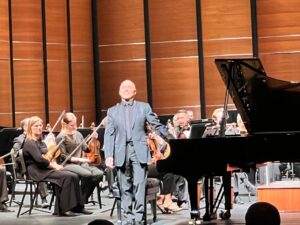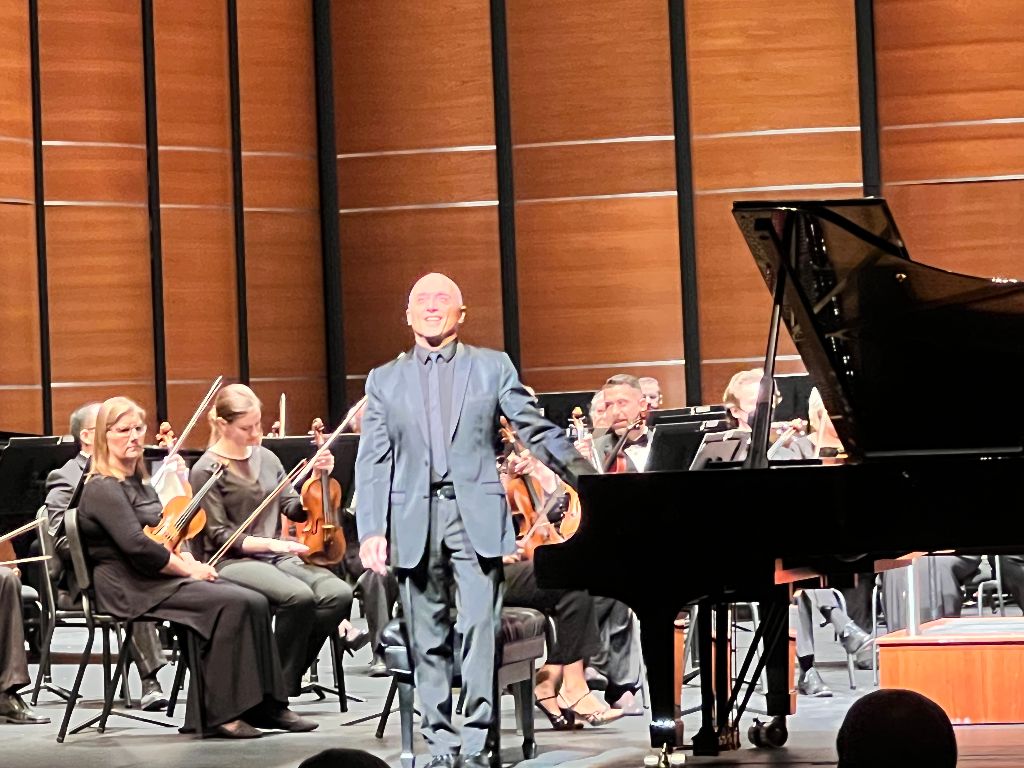The Austin Symphony Orchestra opened its 112th season with a superlative programme this past weekend.
Acclaimed pianist Benedetto Lupo gave the audience a marvellously nuanced interpretation of Ravel’s Piano Concerto in G major, first performed in 1932. It opens in quite a sprightly manner – first with the crack of a whip, then a perky tune on the piccolo and then a trumpet solo. Dissonant notes on the piano mark this out at once as an avant-garde composition, very much of its time. But the very moody interplay between the harp and a lengthy glissando on the piano truly set this concerto apart. The first movement ends on a rollicking style.
The second movement opens with a piano solo of delicacy and warmth entirely lacking in the first. What we hear is a beautiful melody that exemplifies the finest tradition of a piano concerto. This is perhaps not too surprising when one reads it was modelled after a composition by Mozart. The orchestra very gently joins in, first with the double bass instruments, then with the violins. But the violins soon fall silent again allowing Lupo and the larger stringed instruments to explore the nuances of melody on their own. Quite marvellous. The brief third movement is a horse race between the piano and the orchestra, each one literally galloping forward to best the other as they reach the finish line, appropriately enough with another crack of the whip! It’s not Bolero, but this Piano Concerto is a cracker.
The concert opened with a rarely-heard modern piece from 1997, Wondrous Light, by John Estacio. Inspired by the aurora borealis, this is the second half of Borealis. Electric energy is evoked early on, with electrons dashing about. In Paradise Lost, Milton evoked the image of gonfalons fluttering in the breeze to poetically describe the aurora. Aurally, Estacio does the same here with the trumpet, and the whooshing sound that can very rarely be heard when an aurora is dominating an Arctic sky is nicely evoked here by the symphony. The full glory of the aurora is on display at the work reaches its final phase. The programme notes state “Sudden swells in volume accompanied by quick glissandos were inspired by the swirling curtains of green light which twist and turn and vanish suddenly in the night sky.” Sadly, the one thing this work cannot do is selectively identify colours in the aurora, which include green and red. Unless, perhaps, if you have synesthesia.
All this was a prelude to the second half of the concert, with Tchaikovsky’s immensely powerful Symphony No. 4 in F minor, premiered in Moscow in 1878 to only lukewarm success. One wonders what they were thinking. Remarkably, we DO know what the composer was thinking, as he related his own thoughts about the composition to his close friend Nadezhda von Meck.
A grand fanfare begins the Symphony, which seems to gradually recede into the distance as the horns get ever fainter. Tchaikovsky wrote that this represents fate, “that fateful force which prevents the impulse to happiness from attaining its goal, which jealously ensures that peace and happiness shall not be complete and unclouded, which hangs above the head like the sword of Damocles, unwaveringly, constantly poisoning the soul. It is an invincible force that can never be overcome—merely endured, hopelessly.”
A lovely melody develops. In a swaying rhythm the violins alternately enter and leave. Eventually all the instruments join forces to issue a proclamation, a joyous expression of some wonder. This is confirmed by what the composer writes. “Out of nowhere a sweet and gentle day-dream appears. Some blissful, radiant human image hurries by and beckons us away. Everything gloomy and joyless is forgotten. Here it is, here it is – happiness!” With horns blazing and the strings at maximum volume, no one could ever say they dozed through this one.
The second movement is a truly ‘symphonic’ score in the finest tradition of that term. Tchaikovsky wrote that its opening oboe solo evokes “that melancholy feeling which comes in the evening when, weary from one’s toil, one sits alone with a book—but it falls from the hand. There comes a whole host of memories.” As it develops, it was meant to suggest “Happy moments when the young blood boiled, and life was satisfying.” This classically elegant melody was beautifully expressed by maestro Peter Bay and the orchestra.
The pizzicato strings that open the third movement are most unexpected and are designed, said the composer, to describe “images which sweep through the head as one falls asleep.” A rollicking good time (“a picture of drunken peasants and a street song”) is next vividly brought to life by the woodwinds and brass. The fourth and final movement features bombastic outbursts that gave the Austin Symphony the opportunity to show what a full orchestra is fully capable of. Tchaikovsky modestly called it “the festive merriment of ordinary people.” Here, he transformed that merriment into an eternal celebration.
For tickets to future performances:
www.austinsymphony.org

